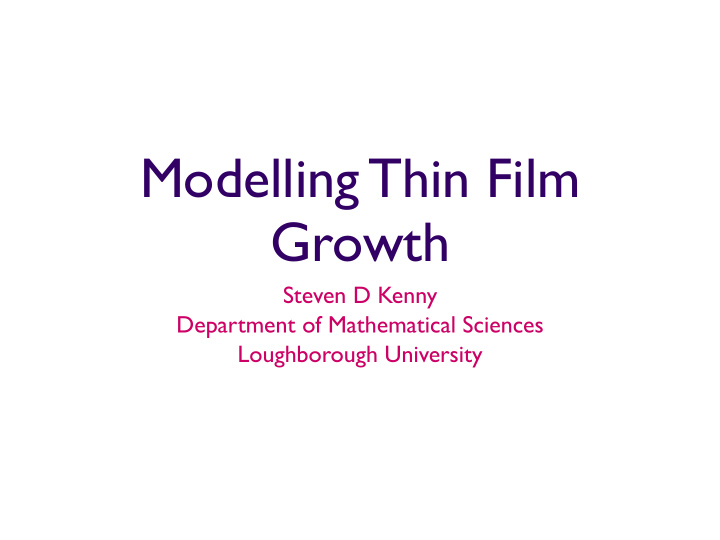



Modelling Thin Film Growth Steven D Kenny Department of Mathematical Sciences Loughborough University
Outline • Methodology • Results • Challenges • Conclusions
Methodology • HTST, fixed prefactor • Mixed MD - otf-kMC • On-the-fly kinetic Monte Carlo Methodology • Defect identification • Saddle point search • Barrier Calculation • KMC Step • Repeat
Methodology Queue Searches Saddle Search Saddle Search Saddle Search Relax Relax Relax CI-NEB CI-NEB CI-NEB Collect moves KMC Move Write Data
Methodology • Searches are queued and executed when cores are free. • Mixture of dimer method and RAT used for saddle searches. • Relaxation performed to find final state. • CI-NEB used to find barrier height. • Duplicate saddles discarded. • Roulette table constructed and move chosen. Graeme Henkelman and Hannes Jónsson, J. Chem, Phys. 111 7010 (1999) L. Vernon PhD Thesis G. Henkelman, B. P. Uberuaga, and H. Jónsson, J. Chem. Phys. 113 , 9901 (2000)
Results • Simulations of growth of thin films of interest for PV applications. • Growth of Al and Ag (100) and (111) films - contacts and concentrators. • Growth of ZnO - TCO. • Growth of TiO 2 - AR coating.
Growth of Al and Ag • EAM type potentials. • 6 initial layers of metal. • 4 new layers grown. • 10 ML/s growth rate - 350K temperature. • Growth energies of 1 eV and 40 eV. • Optional co-deposition of Ar.
Al (111) Growth
Concerted Motions
Growth of TiO 2 • Variable charge potential used. • Modified to reproduce important transitions. • 6 initial layers. • 4 new layers grown. • Deposition rate 0.5 ML/s - 350 K.
TiO2 Growth
TiO 2 Growth 1 #- $%&'$()*&+$ $$,2$&3$45%$6&)7$ !22$&3$45%$6&)7$ , #- $%&'$()*&+$ . +/ $%&'$()*&+$ 0 %/ $%&'$()*&+$ ! "# $%&'$()*&+$
Multiple Collision Cascades • 1 keV collision cascade modelled by MD for 20 ps • Subsequent diffusion modelled by otf-KMC • Collision cascades performed every 0.2 s, simulates ion implantation rates • Total of 3 collision cascades modelled
Concerted Events
Challenges • Speed • Fidelity
Speed • Main cost is function evaluations - 98-99% of time. • Need to minimise by choice of methodology and parameters. • Filtering out low energy transitions that don’t contribute to system evolution. • Issue in most systems we have studied.
Challenges
Fidelity • How many searches is enough? • Fixed number of searches checked to see whether sufficient.
Conclusions • Very powerful tool for studying evolution of systems. • Can already study real systems. • Still work to be done on refining the methodology. • Developments needed: • Auto-identification of events that don’t contribute to the system evolution. • Understanding when to stop searches.
Acknowledgements • Roger Smith • Chris Scott, Sabrina Blackwell, Zainab Al Tooq, Tomas Lazuaskas, Louis Vernon, Marc Robinson, Ed Sanville, Stewart Gordon, Hurry Hurchand • AWE, EPSRC, EU
Recommend
More recommend